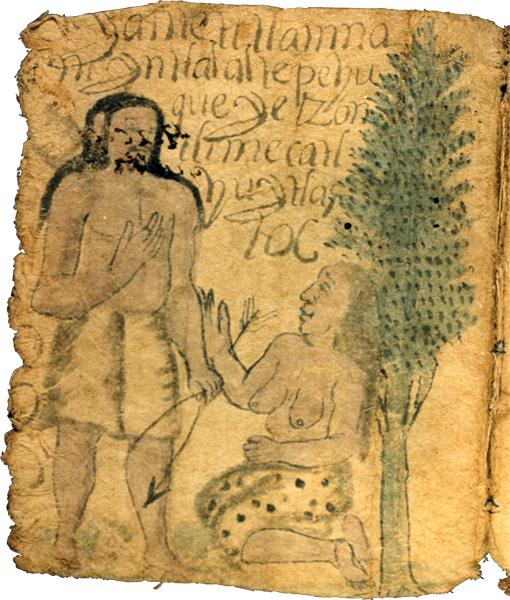Bk. IV, f. 1v., couple at Yametitlan
This page, which is the back face of the first folio of sixteen folios (32 pages of texts and images, divided some years ago into separate “books” without any certainty about numbering or page order), is also 1 verso of Book IV. It is typical of the image-heavy pages that feature landscapes included in these territorial claims of Santa María Iztacapan (modern State of Hidalgo, Mexico) late in the Spanish colonial period. This scene, of a couple, includes a short text written in Nahuatl.
In this scene we see an indigenous man with long black hair, possibly a mustache, wearing what appears to be an animal skin from his waist to his knees, a quiver on his back, and carrying an arrow and possibly a bow in his left hand. He stands over an indigenous woman, seated on the ground with her legs tucked under her, wearing a spotted animal skin skirt and no blouse. Her breasts are bare, as are her feet. His feet and chest are also bare. He is gesturing with his right hand over his heart or chest. She is gesturing with her right hand held up toward him. Her left hand is at her waist. Both figures have their hair long and flowing.
A tree, outlined in black and washed with a blue-green, appears to the right of the woman. Text appears at the top of the page.
From the text we learn this place is called Yametitlan. Lands owned by the citizens of Iztacapan extend three “counts” of cords used to measure the land in this vicinity. One to four counts of land is not unusual in these manuscripts.
It may be that the painters put the human figures on the page first, the tree next (for some of its branches are squeezed in around the woman's head), and the text third. Little room was left for the three circles, which appear on the left margin of the page. [SW]
página entera de un folio (pintura y texto)
Esta página, es la cara posterior del primero de dieciseis folios (32 paginas de texto e imágenes, divididas hace algunos años en diferentes “libros” sin ninguna certeza de su numeración u orden de las páginas), es también un verso del libro IV. Es típico de estas páginas cargadas de imágenes que muestran paisajes incluídos en reclamos territoriales de Santa Maria Iztacapan (hoy en día, Estado de Hidalgo, México) en la última etapa del período colonial. Esta escena de una pareja incluye un pequeño texto escrito en Nahuatl.
En esta escena vemos a un hombre indígena con pelo largo, posiblemente un bigote, vestido de lo que parece ser una piel animal desde su cintura a las rodillas, una aljaba en la espalda y cargando una flecha y posiblemente un arco en su mano izquierda. Está parado al lado de una mujer indígena, arrodillada en el piso vistiendo en una fallda de piel de animal con manchas y sin blusa. Sus pechos están descubiertos como así también sus pies. Los pies del hombre y su pecho también están descubiertos. El hombre aparece gesticulando con su mano derecha a la altura del corazón, y ella gesticula con su mano derecha apuntando hacia él. Su mano izquierda se encuentra a la altura de su cintura. Ambas figuras tienen el pelo largo y suelto.
A la derecha de la mujer aparece un árbol delineado en negro y pintado con acuarelas verdes y azules. En la parte superior de la imágen hay un texto escrito. Del texto sabemos que este lugar es llamado Yametitlan. Las tierras que pertenecen a los ciudadanos de Iztacapan se extienden por tres tzontli. No es inusual en estos manuscritos encontrar de uno a cuatro tzontli de tierra en áreas rurales para cada comunidad
